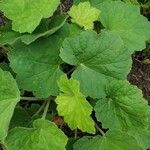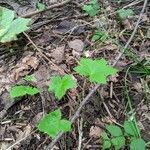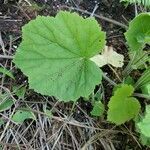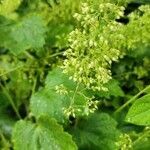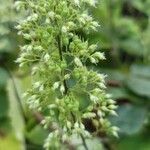Herbs caulescent; caudex branched. Flowering stems 10-85 cm, long stipitate-glandular. Leaves: petiole long stipitate-glandular; blade rounded-cordate, orbiculate, or oblong, often ± polygonal, deeply (5-)7-9+-lobed, 3-26 cm, base cordate to nearly truncate, lobes ovate to triangular, margins dentate to serrate, apex obtuse to acute, surfaces glabrous or long stipitate-glandular. Inflorescences dense to diffuse. Flowers: hypanthium radially symmetric, free 0.2-0.5 mm, white or pink, obconic or subglobose, 1.5-3.6 mm, usually long stipitate-glandular, sometimes sparsely long-stipitate or glabrous; sepals erect, green-tipped, equal, 0.5-1.7 mm, apex rounded; petals often coiled, sometimes reflexed, white, linear, lanceolate, or oblanceolate, unlobed, 1-3 mm, margins entire; stamens exserted 2-2.5 mm; styles exserted 1.5-2.5 mm, 2-4 mm, to 0.1 mm diam. Capsules ovoid, 3-6.4 mm, beaks divergent, not papillose. Seeds dark brown, fusiform, 0.5-0.9 mm.
More
Plants 2–8 dm; scape with a few small, scale-like bracts; lvs angular, with triangular, acute lobes and teeth, rough-hairy on both sides, or mainly on the lower side or only on the veins beneath; petioles and stems ± spreading-villous with multicellular trichomes; infl congested at anthesis, with pedicels to 3 mm, later more open; fls regular, 1.5–3(–3.5) mm at anthesis (measured to the sep-tips); hypanthium glandular-villous, the free part to 0.5 mm, shorter than the adnate part, white or pink, usually with green-tipped sep; pet white to pink, linear, entire, often spirally coiled, much exceeding the sep; stamens exserted; seeds sharply muricate; 2n=14. Moist, shaded ledges and cliffs, especially on acid rocks; irregularly distributed from the mts. of Va. and W.Va. to S.C. and Tenn., w. to s. Ind., Mo., and Ark.; rare in w. Pa. and w. N.Y. Late June–Sept. Ours is var. villosa. Var. arkansana (Rydb.) E. B. Sm. is Ozarkian.
